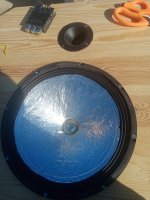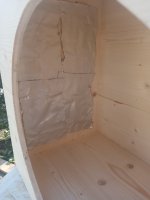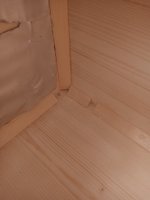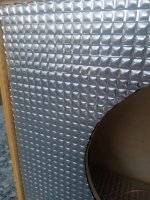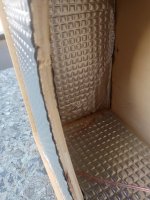Again, a test with a non CLD plywood panel would give some insight. Is the plywood panel behaving worse due to being softened somewhat by the weight of the CLD schedule?
The first set of measurements I posted included a couple different plywood panels. There were 3 different thicknesses tested, and a composite panel made from thin ply over a balsa core.
I built a test stand and re-measured all the panels. The new test stand is still pretty low effort, but it has a lot of mass and it features toggle clamps to hold down the 4 corners of the panels (only contact is at the corners). This ensures that the panel can't bounce at low frequencies, so I should just be measuring the vibration of the panel, not any pistonic movement of the panel bouncing. I think the new measurements better capture what is happening at lower frequencies.
Attachments
Carbon Panel test. One carbon panel is thin and symetrical, and the other is thin carbon on one side, and a carbon/ balsa sandwich on the other side.
Interestingly, the panel that is carbon/ urethane/ carbon&balsa is approx 0.4" thick, but performed similarly to the 0.75" MDF.

The thin carbon/ carbon panel compared similarly to the the fiberglass panels, but carbon was slightly higher (worse). I still need to see what happens with a different durometer or urethane.
Also, with the fiberglass (FRP) panels, the thicker urethane did slightly better at low frequencies, and the thinner urethane did better at high frequencies. So there may be more nuance to the advice that "thin is better". I think it will be worth testing thicker urethane layers after all. And a softer durometer also.

At this point I'm thinking I should go crazy and try combining carbon with fiberglass or flax. Use the carbon to make a thin but rigid panel on one side, with a thin layer of fiberglass or flax on the other side.
Interestingly, the panel that is carbon/ urethane/ carbon&balsa is approx 0.4" thick, but performed similarly to the 0.75" MDF.
The thin carbon/ carbon panel compared similarly to the the fiberglass panels, but carbon was slightly higher (worse). I still need to see what happens with a different durometer or urethane.
Also, with the fiberglass (FRP) panels, the thicker urethane did slightly better at low frequencies, and the thinner urethane did better at high frequencies. So there may be more nuance to the advice that "thin is better". I think it will be worth testing thicker urethane layers after all. And a softer durometer also.
At this point I'm thinking I should go crazy and try combining carbon with fiberglass or flax. Use the carbon to make a thin but rigid panel on one side, with a thin layer of fiberglass or flax on the other side.
Attachments
Durometer will definitively change things. It'll affect thickness of layer too.
Keep experimenting Fredy it's very interesting.
Keep experimenting Fredy it's very interesting.
Durometer will definitively change things.
I just realized I can try silicone for something softer. I have a bucket of the stuff on the shelf...
I did some more tests using polyurethane sealants carried by my local hardware store. They did not have SikaFlex, but I found a few that seemed to have a softer durometer, like around 30 shore A.
I applied the materials with a toothed trowel, and the thickness is approx .030" after being clamped.
The results are a little surprising to me based on previous discussions I have seen. The concensus has been that a softer durometer is more effective, but the softer urethanes do not seem to be very effective in my testing. It is also said that a thinner urethane layer is more effective, but the panel that performed better had a thicker layer of urethane, and that urethane was stiffer than generally recommended.
(Highlighted measurement is the original 60A urethane panel, other measurements are the softer/ thinner sealants I just measured)

Granted urethanes are a complicated subject, and I am not a chemist! It may just be that the chemistry of these different sealants is not suitable for the application. But that said, I'm hesitant to spend more money testing other polyurethane sealants when they do not seem to be working very well.
I will need to think through what the next step will be. Remembering that the Dynamat seemed to work fairly well, I looked for butyl sealant in a roll, that does not already have an aluminum backing. No luck. However, I do have a case of butyl sealant tape for sealing vacuum bags. I may try sticking panels together with sealant tape, maybe running a strop every 1" or so. Then I can see if an aluminum sheet and butly tape works better than automotive sound deadening products.
I applied the materials with a toothed trowel, and the thickness is approx .030" after being clamped.
The results are a little surprising to me based on previous discussions I have seen. The concensus has been that a softer durometer is more effective, but the softer urethanes do not seem to be very effective in my testing. It is also said that a thinner urethane layer is more effective, but the panel that performed better had a thicker layer of urethane, and that urethane was stiffer than generally recommended.
(Highlighted measurement is the original 60A urethane panel, other measurements are the softer/ thinner sealants I just measured)
Granted urethanes are a complicated subject, and I am not a chemist! It may just be that the chemistry of these different sealants is not suitable for the application. But that said, I'm hesitant to spend more money testing other polyurethane sealants when they do not seem to be working very well.
I will need to think through what the next step will be. Remembering that the Dynamat seemed to work fairly well, I looked for butyl sealant in a roll, that does not already have an aluminum backing. No luck. However, I do have a case of butyl sealant tape for sealing vacuum bags. I may try sticking panels together with sealant tape, maybe running a strop every 1" or so. Then I can see if an aluminum sheet and butly tape works better than automotive sound deadening products.
Attachments
You’re on to something here .I have done a lot of experimentation on enclosure material. I no longer use one type when building a speaker. The reason is that I believe that you need at least two different materials with two different speeds of sound through them. This works to smear out and dampen resonances.
My latest pair is made from oak, birch plywood, a layer of rubbery/tar-like sound dampening material, a layer of foam and/or denim batting, then polyfill. All together it makes the cabinet "dead" when you knock on it.
I've found that building anything out of 1 material is a recipe for disaster whenever oscillation or resonances are concerned. Same is true of bridges, buildings, and speakers. I'd love to love aluminum cone woofers but they do ring and you can hear it even when crossed over properly. (Not to say your results are doomed, just keep your expectations realistic)
Polymer cones or cones made of several different materials just sound better overall to me. Cones made from trees are hard to beat in many ways, as nature has done much of the refining for us in terms of weight, stiffness, and dampening.
Different density for each and opposite wall in the speaker sounds better than using symmetry where resonances will have a ” tune fork” behavior .
This can be done gluing bitumen on each opposite wall, leaving the other untreated . The walls will now resonate at different frequencies because of different weight which is good for the sound .
This is , in my opinion, much more important than using crossbraces everywhere. So, symmetry is the big enemy .
I wouldn’t be surprised if using constrained layer damping on only one of the sidewalls of the speaker sounds better than doing the whole cabinet which will lower the frequency of all resonances in a symmetrical way ( bad for sound )
yes, tried it on a driver with paper cone and aluminium foil.
First time use of silicone glue instead of "normal" household glue.
Work with it is faster and finger snipping test on the cone shows better damping due to the properties of silicone.

First time use of silicone glue instead of "normal" household glue.
Work with it is faster and finger snipping test on the cone shows better damping due to the properties of silicone.
Constrained Layer damping:
A hint I got here from the forum as a key to good sound from sandwich structure.
Now used silicone sealant for applying aluminium foil to the paper cone.
Finger snipping test shows enhanced damping due to the properties of the silicone.
Work goes faster than with the household glue I used usually.

A hint I got here from the forum as a key to good sound from sandwich structure.
Now used silicone sealant for applying aluminium foil to the paper cone.
Finger snipping test shows enhanced damping due to the properties of the silicone.
Work goes faster than with the household glue I used usually.
Attachments
tried metal foil from beer cans (recycling) with a layer of silicone glue just to get it fixed. On 12mm three layer spruce wood.
Its a box for a 38cm fullrange.
Nice and easy idea but it does not do anything at all due to simple knocking test.
Maybe some more sophisticated measurenent would show something....
As I know the effect of alubutyl in car hifi - this works better due to the heavier butyl.
Its a box for a 38cm fullrange.
Nice and easy idea but it does not do anything at all due to simple knocking test.
Maybe some more sophisticated measurenent would show something....
As I know the effect of alubutyl in car hifi - this works better due to the heavier butyl.
Attachments
what works well is glueing in sheets of 1mm thick lead with a strong glue "Montagekleber". This deadens quite well.
If you mean construction adhesive similar to liquid nails or soft polyurethane then I agree those are good choices.
cld with silicone glue and metal foil raises a little bit the resonance frequency of a panel due to more stiffness.
For 12mm spruce wood a heavier damping works better, so not recommendable. The effect is too weak.
Could hear the effect in simple knocking test after doing some basic stiffening on all sides of the box.
Before that knocking on the surfaces made all the box resonate so difficult to hear any effect.
For 12mm spruce wood a heavier damping works better, so not recommendable. The effect is too weak.
Could hear the effect in simple knocking test after doing some basic stiffening on all sides of the box.
Before that knocking on the surfaces made all the box resonate so difficult to hear any effect.
Attachments
I did now. I like the version on his website better. A lot of info, and wide ranging. For CLD, he took a minimally resonant enclosure and added CLD by making the cabinet thicker. This doesn't really help me, because I'd like to reduce material thickness.
I did make thin wall variants. The controls were 1/2" and 3/4". All the experiments were all also 1/2" and 3/4". Except the one where I used XPS foam. It was 1" thick because I couldn't find 1/4" foam and had to use 1/2". The 3/4" experiments were all 1/4" MDF with 1/4" inner layer of some kind. One of the best was simply gluing the 1/4" MDF together with a 1/32" layer of the adhesive. The best adhesive was Weicon Flex 310M Classic. Much tackier than Loctite PL300, and much easier to spread than Sikaflex.
Don't forget driver isolation. I saw a significant improvement just using a thin sorbothane driver gasket and o-rings between the screw heads and driver flange.
this works, alubutyl from car hifi domain for damping doors and metal surfaces
12mm plywood with both sided alubutyl, its 1mm butyul and a thicker layer of aluminium foil
knocking test shows good damping
12mm plywood with both sided alubutyl, its 1mm butyul and a thicker layer of aluminium foil
knocking test shows good damping
Attachments
- Home
- Design & Build
- Construction Tips
- Have You Attempted Constrained Layer Damping (CLD); What did you do and how did it work?
